The mountains have always held a special place in prepping and survival lore. We admire the real and the quasi-mythical mountain man for his determination, grit, endurance, and prowess.
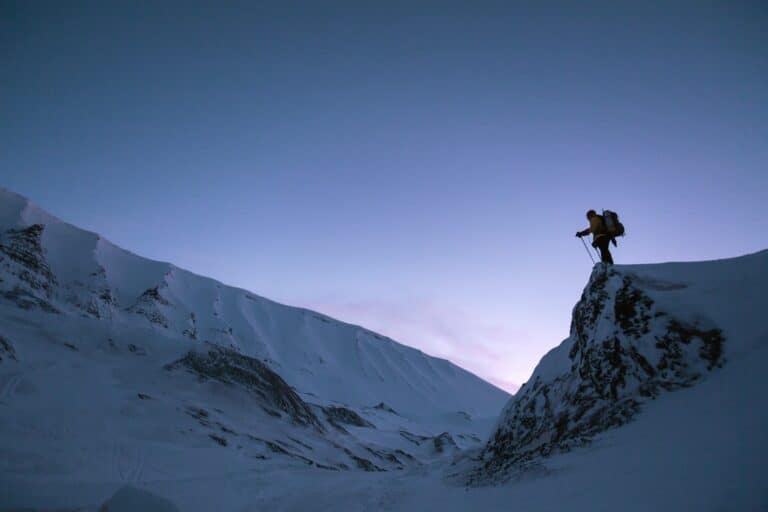
People and tribes since time immemorial have fled to the mountains in times of trouble to find succor and salvation from natural and human threats.
The mountains are also seen as a literal redoubt against rising water and times of unrest.
It is no wonder then that so many preppers plan to pack up and flee into the mountains when the excrement hits the proverbial oscillator.
Whether this is well advised or not is a subject of some debate, and depends largely on the skills that an individual prepper can bring to the table.
Mountains are always dangerous environments, and they do not suffer fools lightly.
An old saying says “you cannot cheat the mountain”, and if you go in half-cocked and overconfident you’ll only be assuring yourself a prolonged and miserable death.
Nonetheless, mountainous terrain can offer the savvy survivor many advantages, and we’re going to equip you with all the information you need to know to do exactly that in today’s article.
Head to the Mountains!
Mountain ranges large and small exist all around the world, though small is always a relative term when discussing mountains.
Throughout the continental United States in particular there are enormous swaths of the nation covered in mountains.
From the old and comparatively short Appalachians to the soaring and jagged though indisputably majestic Rockies, mountains are all over the place and there is no shortage of human habitation near or even on the slopes of these craggy peaks.
It makes sense that plenty of preppers in these areas would plan on fleeing into the mountains during times of trouble.
There’s almost something instinctive about the shelter that mountains can provide when the sky goes dark and times turn anything but certain.
Maybe it is just the primordial notion of attaining a high and seemingly unreachable perch so you can watch the trouble unfold far below.
Not for nothing, for some preppers who would flee civilization and into the wild mountainous terrain is their default wilderness! It might be the only choice if you want to get out of town!
The mountains have always been a more or less viable choice, but these days it is one that most preppers would choose despite lacking all of the information they need to make a good decision.
As I already mentioned, heading into the mountains ill-prepared or not knowing exactly what you’re going to be facing and dealing with can quickly turn into a death sentence.
Living in and surviving in the mountains is hard, there are no two ways about it, though it is and has remained entirely viable. You just need to know what you are doing.
In the following sections we will cover the challenges, advantages, and necessary procedures required for mountain survival.

Challenges of Mountain Survival
Bottom line up-front mountain survival entails risking many hazards for those who would make an attempt at it, whether you are experienced or not.
As I mentioned, mountains do not suffer fools gladly, and the inexperienced will be struck down just as easily as the seasoned mountaineer who falls victim to complacency.
A thorough understanding of the various hazards inherent to mountain survival is mandatory if you want to stay alive for any length of time.
Furthermore, it is imperative that you learn how these various hazards interact and intersect with each other (and your survival prerogatives).
Making a go of it on the mountain is equal parts avoiding the most dangerous circumstances and elements while making the best possible choices regarding your objectives.
If you get one or the other wrong, you’ll have a bad outcome. If you get both of them wrong at once, well, it was nice knowing you!
Weather
The weather on the mountain is different from the weather down on the flatlands.
Depending upon the geographic region and the mountain range in question weather can vary wildly, from entirely seasonal and congruent with the rest of the region to borderline polar conditions at high altitudes.
What all mountains have in common, though, is how variable the temperature can be, and how suddenly storms and other rough weather can overtake them.
Ask anyone who has embarked on a day hike in the mountains that ran just a little too long, and they will tell you that freakish temperature swings are an entirely common occurrence.
A cool morning followed by warm springtime temperatures will be nothing more than a pleasant memory if you are forced to shelter on the mountainside overnight as temperatures plummet to below freezing.
What’s more, the sudden appearance of a rain or snowstorm can dump awe-inspiring amounts of precipitation on you, all while you are in highly exposed terrain.
In conjunction with stereotypically strong winds that tall mountains experience and plummeting temperatures the risk of exposure will take on new and terrifying implications.
Rain can result in mudslides and flash floods through low-lying areas and valleys.
Heavy snowfall can easily result in an avalanche on steep slopes that will obliterate everything down slope from it.
It is crucial that you be prepared for the worst extremes of weather before you ever take off for the mountains.
Terrain
Mountainous terrain makes everything harder. Simply moving around is going to be more arduous owing to the uneven and often unstable ground beneath your feet.
This can affect your timetable when you have to move over or through mountains, and getting slowed down in a time-is-life situation could result in your doom depending on what is at stake.
Steep slopes and shifting rocks also further serve to increase your burden.
Anything that you carry, however heavy or light you think it is, will only sap your stamina more when you must work even harder to stabilize that load while crossing the treacherous terrain of the mountainside.
You’ll be working muscles that you never knew you had and an effort to keep yourself and your pack upright and balanced while scrabbling over a steep slope or a shifting bed of gravel or sediment.
This tricky terrain makes more than travel difficult, as finding a suitable place to create your shelter, whatever it might be, will take even longer.
You’ll have several competing factors to balance, like the size of the site, its stability, and also how protected or exposed it is to wind and weather.
Don’t forget the aforementioned mudslides, floods, and avalanches I mentioned previously, as it wouldn’t do to find a nice place to build only to risk your shelter (and your party!) being wiped out in such an event.
Hazards
Mountainous terrain has even more hazards in store.
Even the shortest of mountains still represent a significant increase in altitude over the surrounding terrain, and in the case of the tallest mountains, is already located in high-altitude regions, you can find yourself a long, long way from sea level.
High altitudes mean a lower concentration of oxygen in the air that you breathe, and though there is much you can do to acclimatize to this low level of oxygen if you have lived long in such a place newcomers will undoubtedly suffer.
Shortness of breath, gasping and a general feeling of tiredness or exhaustion should be expected, and altitude sickness proper is definitely on the table.
The higher you go the worse it will get, and there’s nothing you can do to prevent such an occurrence unless you’re going to bring bottled oxygen with you- something that is effectively out of the question for most preppers under the circumstances.
The mountainous terrain is also nowhere near as accessible as other sorts of terrain, and many locations may have only one reasonably easy way in that also serves as the way out.
Should anything block this path, be it a natural event or a human threat, you might be trapped between a proverbial rock and a very literal hard place.
If your only potential exit is a path of significant technical complexity and physical challenges will you and other members of your group be up to the task, or will you have to face whatever threat is looming and hope for the best?
Lastly, if there was ever an environment that was a slip, trip, and tumble hazard it is the mountains.
Though most mountains are not the sheer rock faces we imagine when we think of them and few preppers will move to or through such environments, you don’t have to be facing a sheer cliff to face a substantial risk of death or grievous injury on the mountainside. A stumble can twist or break an ankle or sprain a knee.
A shortfall may leave you with a concussion or cracked skull and an end-over-end tumble down a steep slope could leave you a broken mess with significant internal injuries, and no cavalry coming.
Distribution of Resources
Mountains are very much a “feast or famine” environment when it comes to using natural resources that survivors can make use of.
This is largely dependent upon your region and the mountain range in question, but many ranges have a distinct lack of vegetation and wildlife that can provide useful materials and meaningful nutrition.
Other mountain ranges might feature comparatively narrow bands where such supplies are plentiful, but they often make poor places for camping due to the inherent risks discussed above in this section.
In such cases, this can mean that significant to travel to and from your bug-out location is necessary in order to procure and retrieve supplies.
The more often you travel the more energy you’ll expand and the more risk you’ll expose yourself to while underway.
Getting yourself properly located on a mountain while still assuring at least some access to needed resources is necessary, but it so happens that it is often extremely challenging.
Advantages of Mountains for SHTF Survival
Not every mountain range is a figurative Mordor, a land with no redeeming characteristics that will only result in your inevitable and painful death.
Like any other biome, mountains have their own advantages that they can offer preppers, and depending on the circumstances these advantages might make all of the trials and tribulations more than worthwhile.
For whatever reason you are fleeing into the mountains, you would be a fool if you fail to take advantage of the following:
Inaccessibility
One of the mountain’s best attributes is also one of its biggest flaws, and that is its sheer inaccessibility of it.
Most people will not attempt to enter the mountains, or scale them in any meaningful way because it is so arduous and difficult.
It is better to go around, go the other way or go anywhere else versus attempting such a challenge. At least, that is the way that most people see it.
Knowing this, you can take comfort and the fact that the vast majority of people who would attempt to get to you, reach you or otherwise interact with you will not even try and those who do are likely to be defeated and repelled by the very terrain they are crossing.
This gives mountain dwellers a significant advantage over their lowland brethren when push comes to shove.
For the survivor, especially for survivors facing long or indefinite-term situations where the usual societal order is going to be upended or erased entirely, you’ll have a distinct edge over threats and competitors.
Defensibility
History provides us with countless examples of defenders utilizing mountainous terrain to extreme advantage.
Defenders usually have an edge in most conflicts, being able to make better use of the existing terrain to best their attackers (unless the attackers bring overwhelming numbers).
Mountainous terrain can make prepared defenders all but unassailable, and allow them to hold out in the face of seemingly impossible odds.
You need only look to the countless lesser conflicts and unending wars in Afghanistan throughout the 20th and 21st centuries for all the proof you require.
When you bug out to a good spot in the mountains chances are that there will be only a select few approaches by which people could even attempt to reach you, and vanishingly few by which they could approach you stealthily and undercover. All are likely easily watched.
This makes you difficult to sneak up on, and even if someone is trying to sneak up on you to catch you unawares they will likely have to do it from a position of disadvantage.
Chances are you will always have the high ground, literally, and most people instinctively understand that attempting to reach or attack someone in a defensible, mountainous location is folly at best or suicide at worst.
Also consider that by the time they reach you they will have undergone a trek of considerable strenuousness, while you will be comparatively fresh for the fight.
Lack of Human Traffic/Competition
When choosing bug-out locations, it pays to consider typical lines of human travel as well as lines of drift, places where people will move through when their typical routes are blocked.
Aside from some highways and dedicated paths that run through mountainous terrain, people will rarely if ever choose to go the “hard way” through the mountains.
This will result in a near-total lack of human traffic and correspondingly less human contact.
The less contact you have with strangers during an SHTF situation the better, as this will always result in fewer threats and fewer unknowns, making your job easier.
You’ll have fewer people competing for what natural resources are in the area and fewer people who can even approach you asking for handouts or for help.
If you want to streamline your survival tasks by reducing unknown contacts during an SHTF scenario, the mountains can hardly be beaten.
Essential Skills, Gear, and Tips for Survival Success in the Mountains
Surviving in the mountains may sound like a long shot if you don’t have much experience in mountaineering, but it doesn’t have to be.
With the right gear, the right knowledge, and the right approach you can survive and thrive in the mountains no matter what you are facing.
Consider the following skill sets, gear, and survival procedures mandatory if you have any plans of retreating to the mountains when the shit hits the fan.
Have Proper Clothing and Layer it Appropriately for the Conditions
Dressing appropriately for the mountains is challenging, to say the least, and this is largely due to the highly variable nature of the ambient temperatures and weather.
But so long as you know what you can expect in your chosen mountain range it is possible to pack the appropriate clothing that can serve you for the duration.
On the easier side of the spectrum, you might need to be prepared for warmer seasonal temperatures during the daytime before a plunge into chilly or downright cold nights.
On the more difficult end, you might have to deal with stereotypically bone-chilling and frozen conditions, especially on the taller mountain ranges or during the winter.
This will necessitate proper layering of clothes if you want to survive exposure while still being able to take care of all the survival tasks you’ll have in front of you.
Dressing properly for frigid, mountain conditions is dependent upon smart layering.
Layering is a process by which your clothing is donned in a specific order with each layer accomplishing a specific objective.
Your innermost, base layer should be a thin, lightweight option that will wick perspiration off of your skin rapidly.
Your middle layer should be a fluffy, thicker option that will trap warm air against your body, insulating you from the cold.
The final, outer layer is a wind and weatherproof shell that will keep precipitation from soaking you and the wind from robbing you of your body heat. Appropriate winter-rated headgear, gloves, and boots are a must, too.
The reason why this multi-layer approach is necessary is because surviving a typical, cold mountain climate is about regulating your temperature, not just keeping as warm as possible.
Believe it or not, getting too hot in a cold environment may kill you!
Why? Simply, if you were to get soaked by sweat and then exposed to cold air you will lose body heat geometrically faster than you would be exposed to the same cold air while dry.
Stories abound of mountaineers working too hard while bundled up and soaking their clothes with sweat, then losing body heat so fast as a result that they quickly expire of hypothermia.
For this reason, it is imperative that you be able to remove and then re-don layers as appropriate to your activity level.
You must stay warm enough that you do not freeze but cool enough that you do not start sweating through your clothing.
Does this sound like too much to do? Too difficult or too complicated? Then I suggest you avoid the mountains as a potential survival retreat.
Learn to Read the Terrain Correctly
A skill that is simple in theory but difficult in practice is reading mountainous terrain correctly.
This is one skill set that you must have constantly “on” if you want to survive and thrive in the mountains.
While moving from place to place you must constantly be assessing your path, both for safety and efficiency.
Especially when the going gets steep it is easy to trudge on in a dogged daze only to make a mistake that will see you taking a painful fall, or at best simply following what you thought was a viable path to a dead end.
The result is wasting time and energy when you’re forced to double back and look for a better route.
Reading the terrain correctly extends to more serious endeavors, such as locating your campsite or homestead in a safe place that will provide you the best combination of what protection can be had from wind and weather.
This way you also stay safe out of the path of any potential avalanches, rock falls or mudslides that might occur as a result of precipitation.
You might think it best to locate your home away from home in a valley or saddle where trees grow in abundance and can provide you with plenty of shelter from the wind.
Unfortunately, when snow melts or heavy rain falls from a passing thunderstorm these areas can be scoured clean by flash floods.
The comparatively level base of a steep slope that is packed with firm, crunchy snow seems ideal in colder areas since it affords you a great place to create a snow cave with accompanying windbreaks.
Regrettably, slopes of this nature are highly vulnerable to avalanches especially after recent, heavy snowfall.
You might decide to stay well away from slopes and trees to build on a flat patch that will make your life easier.
By doing this, you’ll get exposed to howling and scouring winds that can damage your tent or other shelters, carry away lighter gear, and turn you into a frozen popsicle if your clothing isn’t up to the task.
The only way to begin to understand correct terrain reading for mountainous environments is to get out there on the mountains and learn as much as you can about your local range.
Your Shelter Creation Skills Must be On Point
Going hand in hand with the previous section, survival in the mountains mandates excellent shelter creation skills. Exposure to the open air means it is only a matter of time until you succumb.
There are several viable methods for creating shelter in mountainous terrain, depending on the climate, but you have to know what you are doing and it is best to be versed in the selection and employment of man-made shelter options as well as improvised constructions.
For any tall, snowy mountains snow caves are, as mentioned, a perennially good option and comparatively easy to create using little more than a shovel.
Anywhere you have deep or tall drifts of snow you can create a snow cave, and though they remain quite cold inside they provide invaluable insulation and protection from wind.
Snow caves work just as well as an emergency shelter as they do as an interim option until you can create more permanent habitation.
Man-made options like appropriately rated tents can definitely work, and their light weight and ease of setup make them the choice of dedicated mountaineers and adventurers alike.
However, you must take care to secure any tent against the high winds and sometimes ferocious precipitation that can accompany life and travel in the mountains.
Having your tent ripped away from you or crushed is going to leave you in a bad way.
Lastly, more temperate mountain environments with plenty of trees and other natural materials lend themselves to the creation of sturdier, more permanent habitation in the form of small cabins, huts, and similar constructions.
Created properly, these shelters provide excellent protection against wind and precipitation, but you must take care that you allow for the safe use of fire inside if you want to stay truly warm.
These skills require a considerable investment of time and energy to develop and employ, but are a must if you want to make a go of it in the mountains with minimal carried resources.
Know the Mountains
Mountains are so often the subject of stories in lore throughout the regions they are found, but they themselves are also repositories of lore that could prove invaluable to your efforts.
The time to start accumulating this lore and local information is right now, as it will be too late once you have to set off.
You should ask local hikers and professionals who go up on the mountain regularly for various purposes about what routes they take, what sites they have seen, and any particular hazards or areas of interest they know about.
Crack open vintage books and newspapers to look for any stories about digs, mines, or camps that may have existed, even entire towns or villages that were boarded up or merely abandoned, left behind. Any of them could help your efforts to survive.
Similarly, get up on the mountain yourself as it is critical that you scout and explore bug-out locations along with all the routes you can take to get to and out of it.
While doing this, be especially alert for any indicators of trails, left by humans or animals.
These may serve to help you get from place to place, locate probable food sources more easily, or warn you of areas where you might not have an expectation of privacy or isolation.
In an environment that is as unforgiving and severe as the mountains there is no piece of information or intel that is beneath notice. Start accumulating this lore and using it to shape your own plans.
Scoped Rifles are a Must for Hunting and Defense
If there is one environment that essentially necessitates the use of a rifle it is the mountains.
With few exceptions and even then usually only in specific areas or sub-regions, mountainous environments equal long-range shots, on quarry or foe alike.
This means defending yourself and your patch or bagging an animal to supplement your larder will necessitate the range, power, and precision that only a rifle can provide.
Considering that your shots are likely to be over a far longer uninterrupted distance then they would be in other environments, a rifle scope is a must both for target identification and precise shot placement.
Rifle selection is also somewhat more critical than in other environments, as any rifle you take into the mountains is likely going to be subjected to more knocks, bumps, and scrapes than elsewhere. Accordingly, durability and longevity are prime considerations.
This is not to say you will not have any use for a pistol or a shotgun in a mountainous environment, but they will in all likelihood be niche or tertiary weapons for any purpose.
A handgun is, as always, the choice for a sidearm or in extremely cramped quarters, but a shotgun is going to be completely outclassed unless you have a dedicated plan for bagging birds or other small quarry utilizing birdshot.
A rifle lacking a scope will not be able to perform to its full capability in a mountainous environment and other firearms will usually fall woefully short of the requirements for typical shots.
Make sure you pick a capable rifle and equip it with an equally capable magnified optic if you plan on surviving in the mountains.

Additional Gear for Surviving in the Mountains
You’ll need plenty of gear for surviving in the mountains, much of it being the standard fare you are used to seeing in bug-out bag packing lists and elsewhere.
However, there are some items that should be considered absolutely mandatory for heading into the mountains for any length of time. Consider the list below for examples:
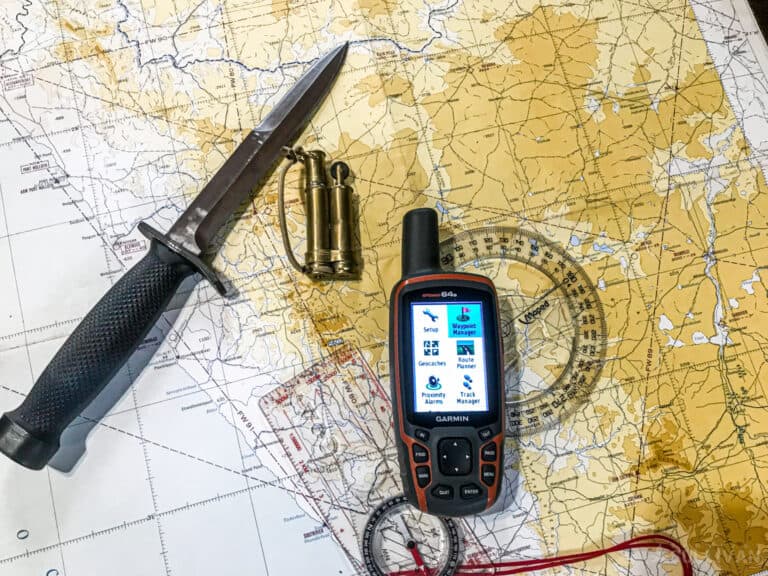
GPS, knife, map compass, and ruler over a topo map
1. Maps and Compass
Getting lost in mountainous terrain is just as likely, even more likely, than in other places.
You’ll need recent, high-quality maps of the region to help keep you from getting lost, and just as important to help you plot safe and efficient routes of travel through the area.
A good map can easily cut down on wasted energy and time, both in the scouting phase and in the event that you need to make use of your BOL for real.
Naturally, consider a compass a mandatory inclusion also. You might think it would be difficult to get turned around in the mountains, but they only seem distinct when viewed from far away.
When you are actually on the side of them, most will look about the same height with maddeningly similar features.
Basic direction finding is an elementary but important advantage whenever you are living in or traveling through mountainous terrain.
However, you must use an extra degree of caution when employing a compass in the mountains because deposits of magnetic ore could potentially influence the reading and send you in the wrong direction.
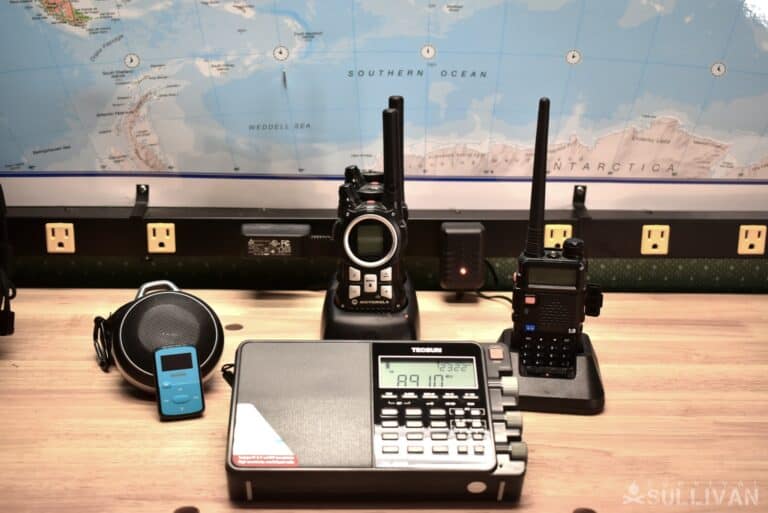
emergency radios: UV5R, Motorolas, ClipJam, and Tecsun
2. Radios
Reliable, radio communication is essential for maintaining contact with members of your group or family.
Considering that mountains can easily interfere with acoustics, radios are even more important here.
Whether you are using them to keep appraised of someone’s progress, a task that they have undertaken or corresponding with someone on lookout duty radios will be a must.
But the same craggy, tall terrain that interferes with typical acoustics can also interfere with radio signals, and this means that maintaining a workable line of signal is important, as is an understanding of radio theory.
Hauling a base set with you along with an antenna that you can erect might be an essential prep to work toward if you plan on making a go of it in the mountains.
At the minimum, handheld GMRS radios or high-quality walkie-talkies will at least allow you to talk to someone who is far up or down slope from your location so long as they are on the same side of the mountain.
3. Signaling Equipment
Signaling equipment is always vital in a preparatory capacity but it is especially vital in the mountains where long sight lines are more likely than elsewhere.
For emergency signaling or basic communication, there are all sorts of visual and auditory signals that you can employ to help get your point across.
Colored flags, tarps, or even large handkerchiefs are one, and can be used as status indicators or for actual communication with a code like semaphore.
Flares and flare guns are another worthwhile inclusion. Don’t forget you can also signal with your flashlight in dark conditions.
Simple codes of call and response can be worked out ahead of time using light for signaling, or if both parties are fluent in Morse code you can use that.
Auditory signals also have considerable value in the mountains since the acoustics can help you as much as they hurt you.
General distress signals sounded by the blast of a horn or even gunfire can alert distant party members that they are needed back at base post haste.
Don’t be afraid to be creative, just make sure you have a plan and gear in place for signaling.
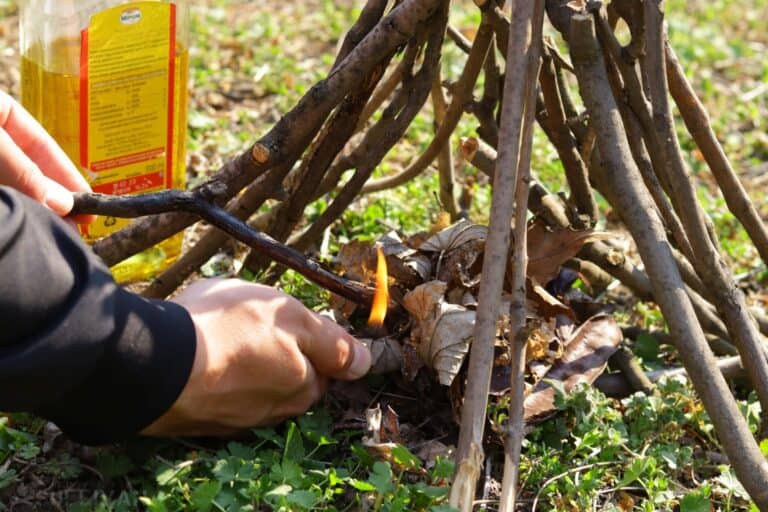
starting a fire with sticks and cooking oil
4. Fire Starting Kit
As mentioned above mountains get cold, and they can get cold fast. The risk of exposure is greatly amplified in mountainous terrain and accordingly you must be prepared to create a fire on demand pretty much wherever you might be.
For this reason, an enhanced fire-starting kit is a mandatory inclusion for mountain-specific survival.
You should have no less than three reliable, “high percentage” ways to start a fire along with a good supply of tinder to assist.
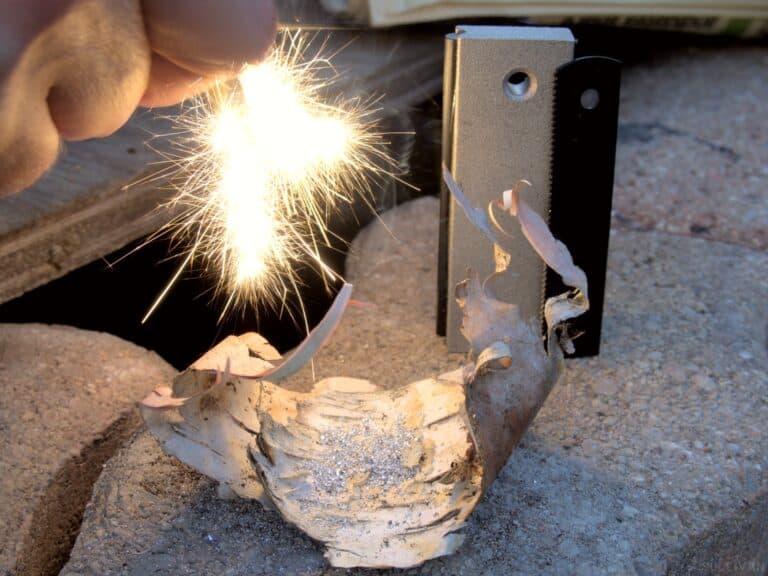
As always, lighters and ferro rods are an excellent inclusion, but for mountainous terrain in particular I would also include a binary chemical fire starter that will produce roaring flames even if your hands are already so numb from cold that you lose all dexterity.
In short, you can never be too cautious when it comes to fire-starting equipment in the mountains.
5. Tent
Unless you are heading to a pre-built structure and mountains you can generally be assured that any worthwhile shelter you are going to create will take some time and if my own experience is anything to go by it will be a far more arduous process than you might be anticipating.
For that reason, consider a high-quality climate-rated tent a mandatory inclusion from a life support perspective.
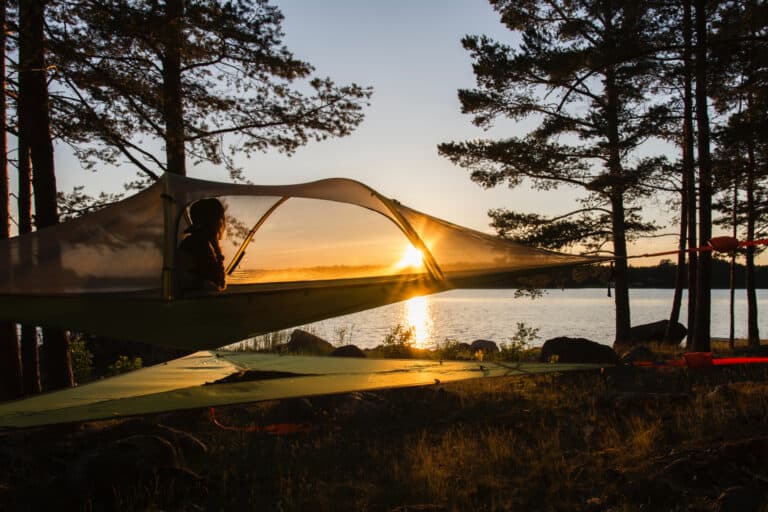
a tree tent
If you run behind, can’t find the materials you need, or are just overtaken by events having a tent that is ready to be set up, easily, will provide you invaluable shelter before things get too bad.
Tents have their own shortcomings as I have mentioned above, but their advantages far outweigh these shortcomings under the circumstances.
However, setting up a tent in seriously rough terrain is a skill unto itself, and you would be well advised to head out and get experience while it is elective instead of mandatory.

6. Sleeping Bag
Like the tent, consider a properly rated sleeping bag a mandatory inclusion for any mountain outing.
If you can do nothing else but crawl inside your tent and then into a warm sleeping bag you will have a major leg up over the outside conditions no matter how chilly they are.
Sleeping bags that are rated for the kind of cold typically encountered in mountainous regions are often expensive and very bulky, but nothing even comes close when you really need to stay warm.
7. Trekking Poles
Trekking poles, walking sticks, and other similar pieces of equipment are chronically underutilized by preppers.
These devices improve your stability, thereby increasing safety, and decreasing the probability of a fall by giving you additional points of contact with the ground while walking, something that is especially important when moving over the shaky or uncertain ground of the type typically encountered in the mountains.
Even a single trekking pole can drastically increase your stability, and with modern versions being so lightweight and so durable there is hardly an excuse to not carry one.
These items can also be repurposed as additional reinforcement for pitching a tent or securing other gear to the ground.
8. Thermos
Considering you are likely to be facing such extreme temperature swings, a thermos can help you make the most of your fuel investment when cooking by keeping hot liquids hot despite frigid outside conditions.
An extra large thermos with a wide mouth is just the ticket for holding hot coffee, tea, hot cocoa, soup, or stew, ensuring that it is ready to consume at a pleasant temperature and warm you up the next time you need a little break or a meal.

12 inch static climbing Kernmantle rope. Double braid composite construction. Tough polyester jacket with a nylon core.
9. Climbing Gear
When the time comes to move over the steepest faces on the mountain, climbing gear will be necessary for safety.
Various kinds of rope, crampons, helmets, and other equipment fit into this category but a full discussion of the ins and outs of proper mountaineering via ascending and belaying using ropes is beyond the scope of this article.
For preppers in particular, you might want to avoid mountains and routes so steep they require the use of proper climbing gear, but if for whatever reason your plans include traversing such places you will have to come prepared or face extreme risk of injury or death.
Make sure you know what you are doing ahead of time! Trying to scale a sheer face is no time for I’ll figure it out!
Conclusion
Heading to the mountains in an SHTF survival situation is not just the stuff of fiction and is not a death sentence as some portend but it must be undertaken with the utmost seriousness.
Mountains are majestic but typically deadly environments and many dangers will accompany the awesome views in abundance.
But for the prepper who is determined and properly prepared mountains can afford many advantages, especially in long-term survival situations.
Due diligence is a requirement, but with plenty of investment and an equal measure of grit the mountains may serve as the ideal BOL for you.
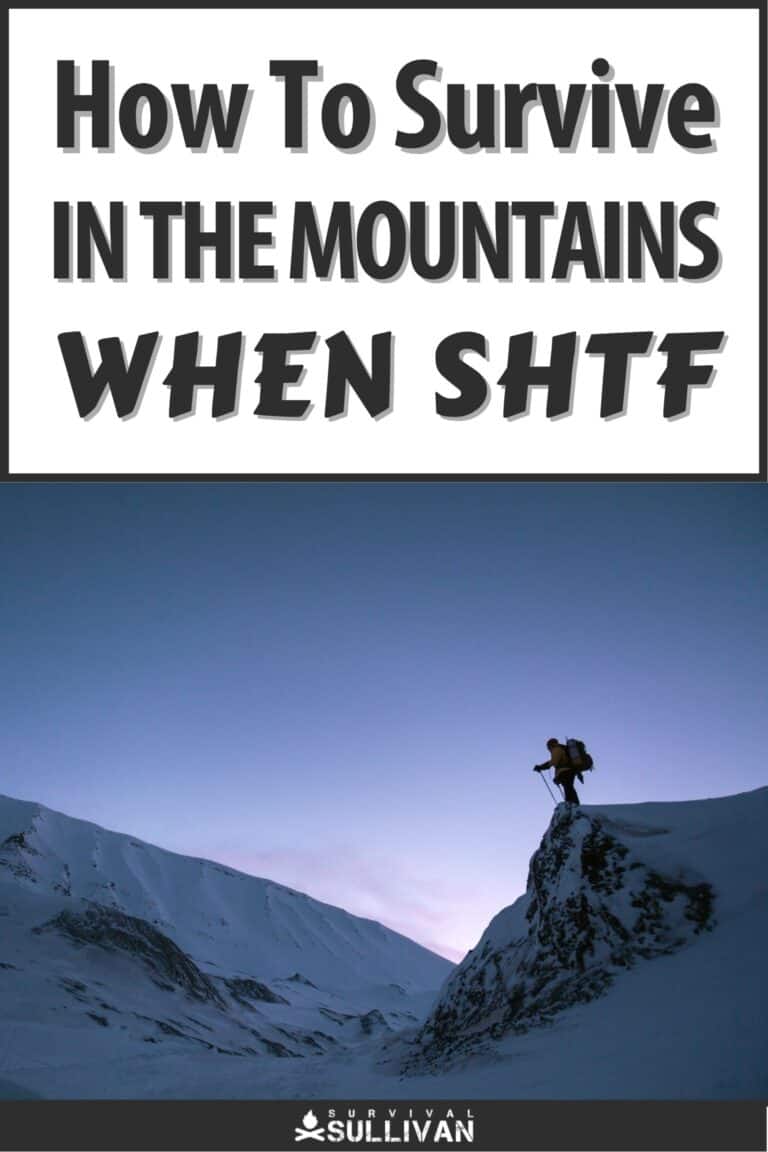
The post How To Survive in the Mountains When SHTF appeared first on Survival Sullivan.
By: Tom Marlowe
Title: How To Survive in the Mountains When SHTF
Sourced From: www.survivalsullivan.com/mountain-survival-when-shtf/
Published Date: Sat, 28 Jan 2023 16:00:00 +0000
------------------------
Did you miss our previous article...
https://bushcrafttips.com/bushcraft-news/pocket-preps-serrated-knife-buyers-guide
 What is BushcraftSurvival SkillsToolsVideosBushcraft CampsBushcraft KitsBushcraft ProjectsPrivacy PolicyTerms And Conditions
What is BushcraftSurvival SkillsToolsVideosBushcraft CampsBushcraft KitsBushcraft ProjectsPrivacy PolicyTerms And Conditions
